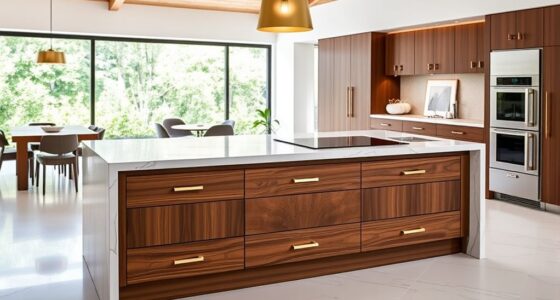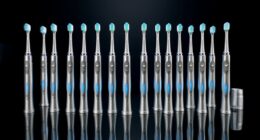If you’re looking to elevate your night sky shots, I recommend exploring options like sturdy tripods made of aluminum or steel with vibration control features, and pier mounts that support accurate polar alignment and stability. Mount compatibility and payload capacity are key, so choose setups that match your gear’s weight. Lightweight, portable designs make outdoor adjustments easier. If you keep exploring, you’ll discover the best support systems tailored to your astrophotography needs.
Key Takeaways
- Durable, high-capacity tripods made of aluminum or steel ensure stability for long-exposure astrophotography.
- Adjustable height and quick-release mechanisms facilitate precise positioning and easy setup in various terrains.
- Pier extensions and mount upgrades improve viewing angles, reduce vibrations, and support heavier imaging equipment.
- Compatibility with popular mounts like EQ6, Star Adventurer GTI, and V-style dovetails enhances versatility.
- Features such as bubble levels, vibration dampers, and elevated pier mounts optimize stability and image sharpness.
Sky-Watcher Star Adventurer GTI Mount Kit with Accessories
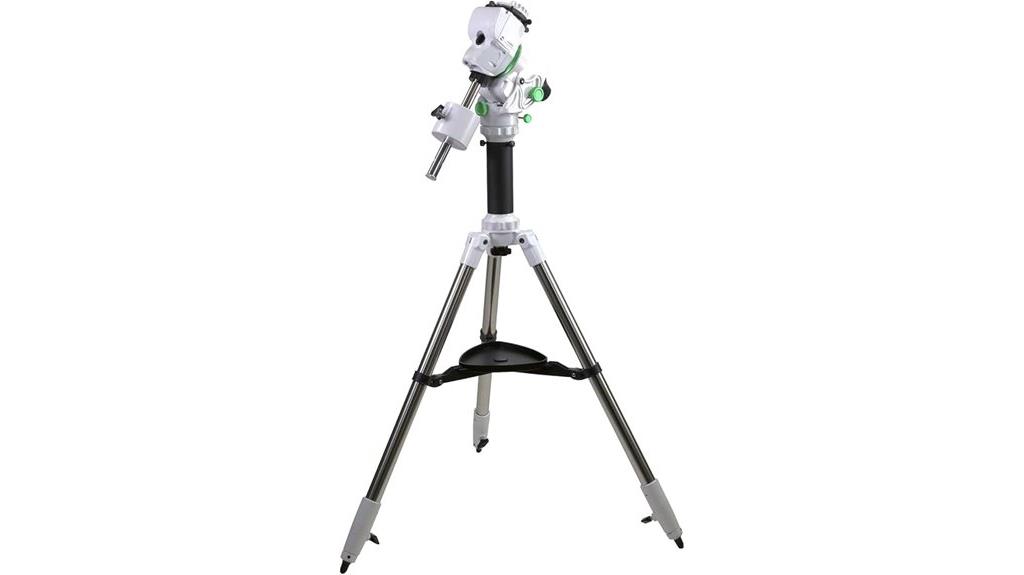
Are you looking for a portable, easy-to-use mount that delivers accurate star tracking for astrophotography? The Sky-Watcher Star Adventurer GTI Mount Kit fits the bill perfectly. It offers full GoTo equatorial tracking in a compact design, with Wi-Fi control via smartphone and a built-in illuminated polar scope for precise alignment. Supporting up to 11 pounds, it handles DSLR, mirrorless cameras, and small scopes. Its lightweight, about 26 pounds, and travel-friendly size make setup quick and straightforward. Users praise its tracking accuracy and ease of use, especially for unguided images up to three minutes. This mount is ideal for both beginners and seasoned astrophotographers seeking portability and reliability.
Best For: amateur and experienced astrophotographers seeking a portable, user-friendly mount with accurate tracking capabilities for wide-field and small telescope astrophotography.
Pros:
- Compact, lightweight design ideal for travel and field use
- Wi-Fi connectivity enabling smartphone control and easy setup
- Built-in illuminated polar scope simplifies alignment and improves tracking accuracy
Cons:
- Limited payload capacity (11 pounds) may restrict heavier setups
- Some users report concerns over build quality and durability, particularly with accessories
- Polar scope cover and counterweight system may require upgrades for heavier or more precise applications
iEXOS-100-2 PMC-Eight Astrophotography Tracker System with Tripod and Mount
The iEXOS-100-2 PMC-Eight astrophotography tracker system is an excellent choice for photographers who need a lightweight, portable mount capable of precise star tracking. Its integrated PMC-Eight system uses eight independent CPUs, ensuring fast, reliable responsiveness. The mount features quiet stepper motor belt drives, dual-axis worm gears, and intuitive app control via ExploreStars, making alignment and navigation straightforward. Constructed from lightweight materials, it weighs around 20 pounds and includes a battery pack, with options for external power. While tripod legs may be somewhat flimsy, the system offers solid tracking performance and compatibility with lightweight telescopes and cameras, making it ideal for mobile astrophotography setups.
Best For: astrophotographers seeking a lightweight, portable, and reliable tracking mount compatible with lightweight telescopes and cameras for mobile astrophotography.
Pros:
- Integrates advanced PMC-Eight system with eight independent CPUs for fast responsiveness and reliability
- Quiet stepper motor belt drives and dual-axis worm gears ensure smooth and precise star tracking
- User-friendly ExploreStars app facilitates easy alignment, navigation, and celestial object identification
Cons:
- Tripod legs may be somewhat flimsy, requiring adjustments or enhancements for stability
- Control software and connectivity can be finicky, with potential issues in GoTo accuracy and maintaining connection stability
- Limited out-of-the-box Bluetooth support and somewhat complex setup process may pose challenges for beginners
Sky Watcher Star Adventurer Tripod
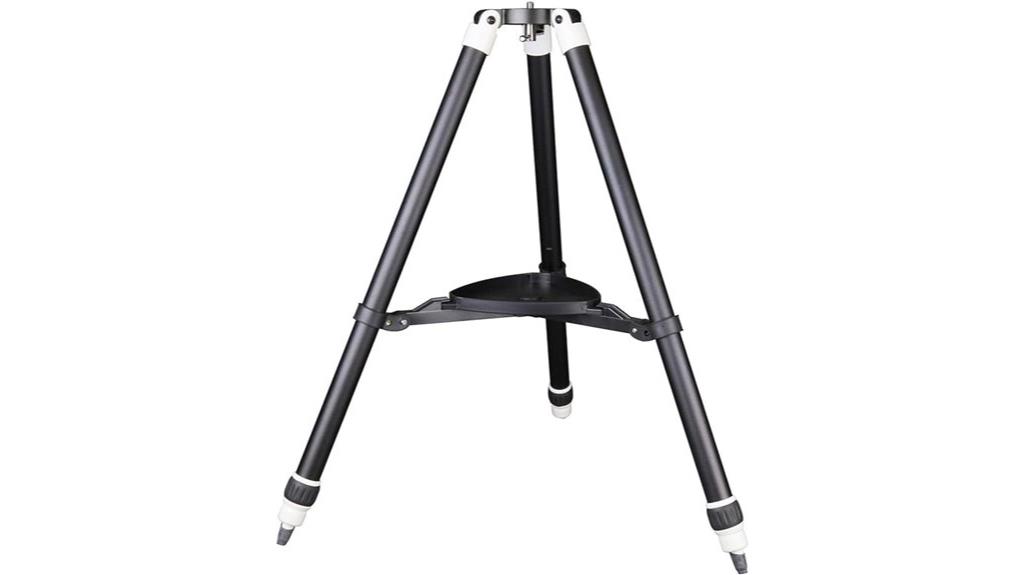
For amateur astronomers seeking a reliable, lightweight tripod that can handle a variety of mounts and accessories, the Sky Watcher Star Adventurer Tripod stands out. It’s crafted from quality materials, offering high stability with no flexure, even in windy conditions. Its adjustable height and easy setup make it perfect for travel and outdoor use, supporting mounts like Star Adventurer Mini, GTi, AZ-GT, and AZ5. Weighing just under 5 pounds, it’s portable yet robust enough for short tube refractors, Maksutov-Cassegrains, and smart telescopes. The included accessory tray adds stability, and many users enhance its performance with additional weights or fluid heads.
Best For: amateur astronomers seeking a lightweight, stable, and portable tripod to support various mounts and accessories for outdoor and travel astrophotography.
Pros:
- Highly stable with no flexure, even in windy conditions
- Adjustable height and easy setup for quick leveling and portability
- Compatible with multiple mounts and accessories, including fluid heads and leveling bases
Cons:
- Some users find the accessory tray’s twist-lock mechanism may misalign if not properly positioned
- Additional weights or accessories may be needed for maximum stability in very windy environments
- Slightly limited maximum height compared to larger tripods, which may affect taller users
iOptron Mini Pier Tripod Extension for CEM60 and MiniTower Mounts
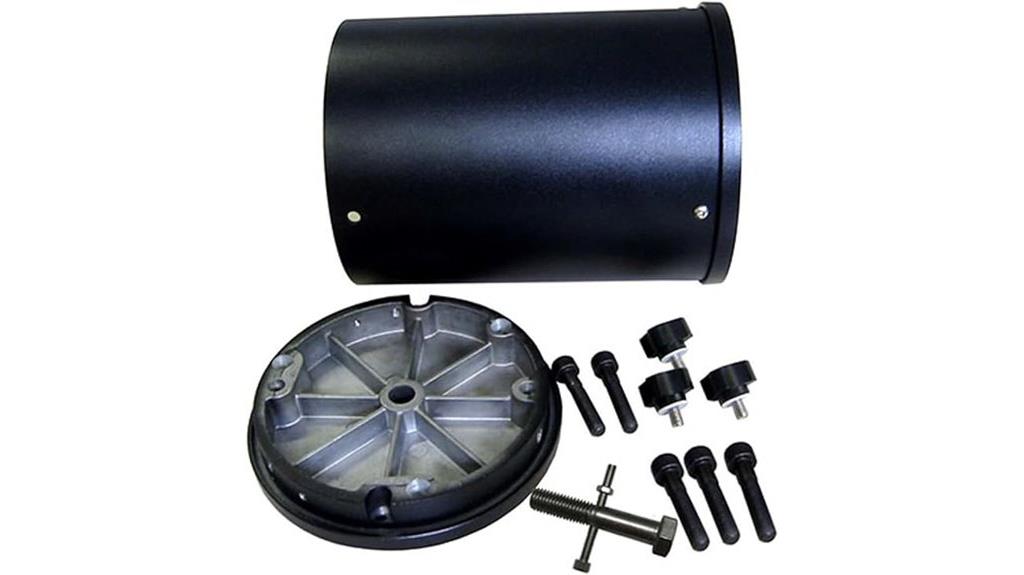
If you’re using a CEM60 or MiniTower mount for astrophotography, the iOptron Mini Pier Tripod Extension is an excellent upgrade to enhance stability and viewing angles. It’s compatible with MiniTower, MiniTower II, and MiniTower Pro mounts, featuring a 5.7-inch pier diameter and 6-inch flange plates for seamless integration. The extension elevates your setup by 8 inches, reducing ground obstructions and improving your viewing position. Crafted with durable materials and multiple hex screws, it provides a secure, stable platform that minimizes vibrations. Plus, it includes alignment pegs for precise polar alignment, ensuring sharper images and smoother tracking during your night sky sessions.
Best For: amateur and professional astronomers seeking to improve stability and viewing angles with their CEM60, MiniTower, or MiniTower II mounts for astrophotography and astronomical observations.
Pros:
- Enhances stability and reduces vibrations for clearer images and better tracking.
- Elevates the telescope setup by 8 inches, improving viewing angles and preventing ground obstructions.
- Includes precise alignment features like pegs and a center stud for accurate polar alignment.
Cons:
- May require additional tools or expertise to install securely.
- Compatibility limited to specific mounts and towers, not universal for all telescope setups.
- Slightly increased setup complexity due to added components and adjustments needed.
Sky-Watcher AZ-GTI Portable Computerized Mount
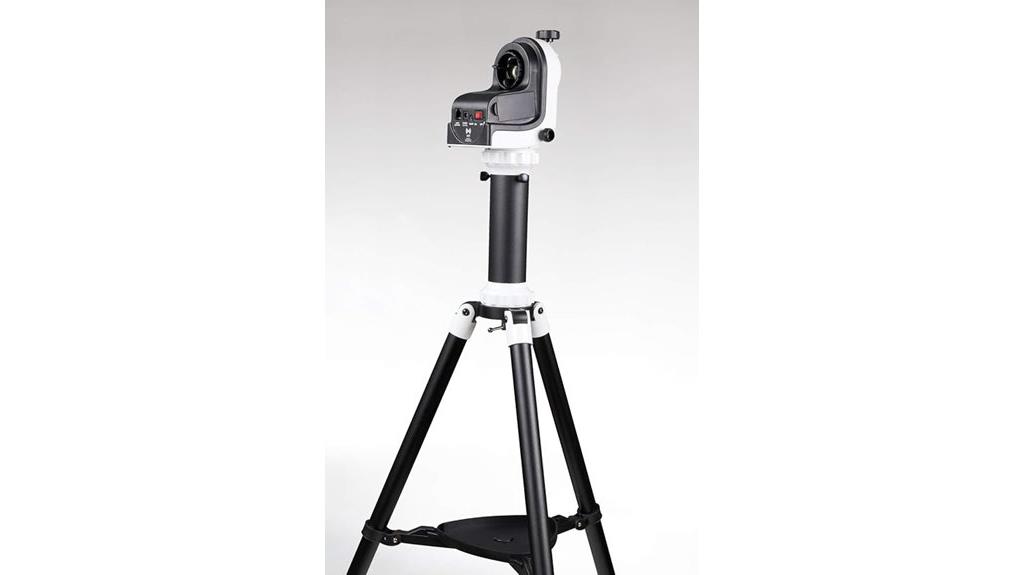
Looking for a portable mount that combines ease of use with precise tracking? The Sky-Watcher AZ-GTI fits the bill perfectly. Weighing just 8.6 pounds, it’s easy to carry and set up anywhere. Its adjustable aluminum tripod extends from 28 to 53 inches, offering comfortable viewing angles. It supports payloads up to 11 pounds, handling most telescopes and cameras. WiFi-enabled and controlled via the SynScan Pro app, it offers effortless smartphone control. The dual-encoder technology keeps your alignment accurate, even with manual slewing. Rugged brass and aluminum gears guarantee smooth tracking, making it ideal for astrophotography on the go.
Best For: amateur astronomers and astrophotographers seeking a portable, easy-to-use mount with precise tracking for both observing and imaging on the go.
Pros:
- Lightweight and portable at only 8.6 pounds, ideal for travel and outdoor use
- WiFi-enabled with app control via Sky-Watcher SynScan Pro, offering easy smartphone operation
- Supports manual slewing with dual-encoder technology, maintaining accurate alignment without losing position
Cons:
- Maximum payload of 11 pounds may limit the size of larger telescopes or heavy cameras
- Requires a compatible smartphone or tablet for full control, which may not suit all users
- Limited height adjustment range (28 to 53 inches) may not accommodate very tall or very short users comfortably
iOptron SkyHunter Extension Pier and Tripod

The iOptron SkyHunter Extension Pier and Tripod stands out as an excellent choice for astrophotographers seeking stability and versatility in their setups. Made of durable stainless steel, the tripod features a 1.25-inch diameter and a 3/8-16 threaded mounting hole, ensuring solid support. The aluminum extension pier extends your SkyHunter setup by 7.5 inches, with an 82mm flange diameter and a 58mm tube diameter for added height. It’s compatible with SkyHunter, SkyGuider Pro, SkyTracker Pro, iPano, and other mounts with 3/8-16 or M6 holes. This setup offers reliable stability for capturing clear, sharp night sky images.
Best For: amateur and professional astrophotographers seeking a stable, versatile setup for night sky imaging and observation.
Pros:
- Durable stainless steel tripod provides robust support and stability.
- Aluminum extension pier adds 7.5 inches for increased height and better viewing angles.
- Compatible with multiple mounts and camera setups, offering flexibility in astrophotography arrangements.
Cons:
- Aluminum extension pier may be less sturdy than all-metal alternatives in heavy setups.
- The overall weight of the stainless steel tripod could be heavy to transport and set up.
- Limited to mounts with 3/8-16 or M6 holes, which may require adapters for certain equipment.
iOptron Tri-Pier for GoTo Mounts
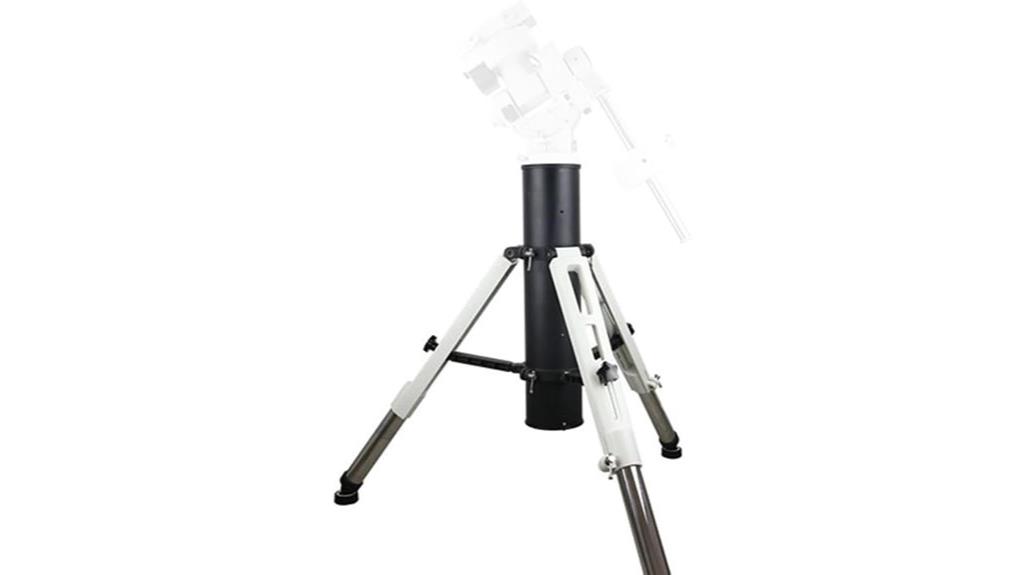
The iOptron Tri-Pier for GoTo Mounts stands out as an excellent choice for astrophotographers who need a stable, versatile support solution that can handle heavy telescope setups. Made from durable aluminum with stainless steel leg extensions, it balances portability and strength, supporting up to 220 lbs. Its adjustable height from 31.5 to 42.5 inches and 3.35-inch leveling range make it adaptable to uneven terrain. The innovative design combines the stability of a traditional pier with tripod-like leveling, making it suitable for both outdoor and studio use. Weighing just 25.8 lbs, it’s easy to transport and set up for reliable, vibration-free astrophotography sessions.
Best For: astrophotographers and astronomers seeking a stable, versatile, and portable mount support for heavy telescope setups in both outdoor and studio environments.
Pros:
- Highly durable aluminum construction with stainless steel leg extensions ensures longevity and resilience.
- Adjustable height (31.5 to 42.5 inches) and leveling range (3.35 inches) provide excellent adaptability to uneven terrain.
- Supports up to 220 lbs, making it compatible with a wide variety of telescope and mount configurations.
Cons:
- Relatively heavy at 25.8 lbs, which may impact portability for some users.
- Slight limitations when used with certain mounts at low latitudes, such as iEQ30/iEQ30 Pro.
- The large dimensions when folded (12.8 x 26 inches) may require ample storage space.
Celestron Heavy Duty Alt-Azimuth Tripod
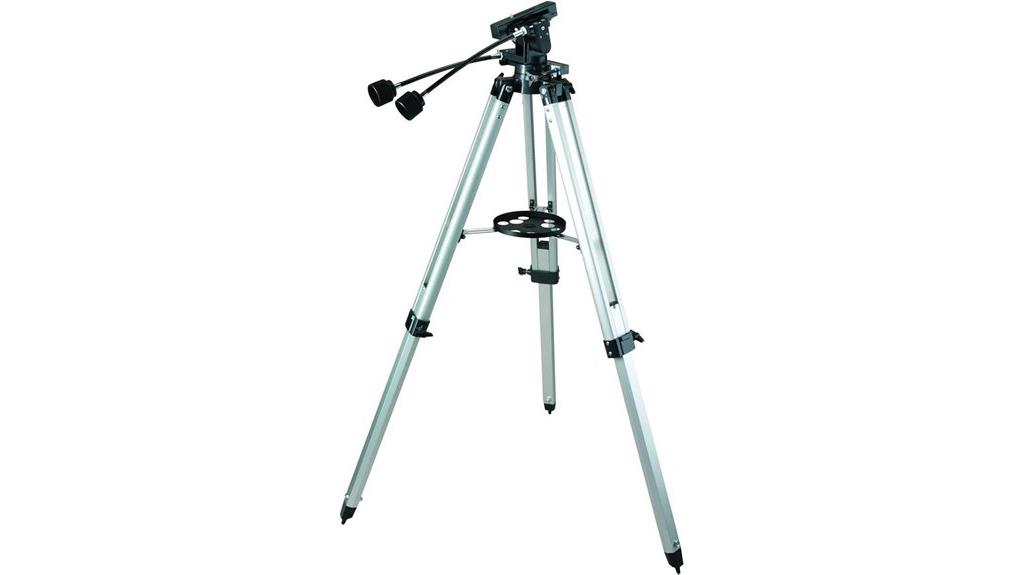
If you’re searching for a sturdy, reliable tripod that can handle various optics during astrophotography sessions, the Celestron Heavy Duty Alt-Azimuth Tripod is an excellent choice. Its robust aluminum build offers superior stability, reducing vibrations for sharp, clear images at high magnifications. Supporting up to 11 pounds, it comfortably holds binoculars, cameras, or small telescopes. The adjustable height from 30.9 to 49.2 inches ensures ergonomic comfort, while its lightweight design of just 7.8 pounds makes transport easy. With quick setup and user-friendly controls, this tripod is perfect for both beginners and seasoned astronomers looking for a dependable, portable platform.
Best For: amateur astronomers, outdoor enthusiasts, and photographers seeking a stable, portable tripod for binoculars, cameras, or small telescopes.
Pros:
- Superior stability with robust aluminum construction minimizes vibrations for clear images
- Adjustable height from 30.9 to 49.2 inches provides ergonomic viewing positions
- Lightweight at only 7.8 lbs with a compact folded length for easy transport and setup
Cons:
- Supports up to 11 lbs, which may limit use with larger, heavier optics
- May lack advanced features found in more professional tripods
- Adjustments might be less precise compared to high-end models
Sky-Watcher AZ5 Telescope Mount
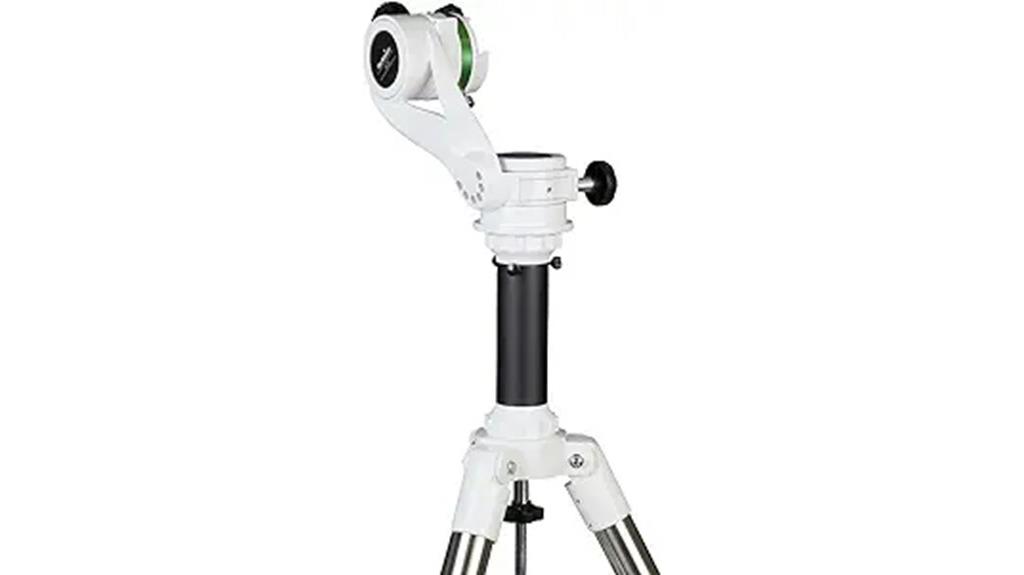
For beginners seeking a portable and stable mount, the Sky-Watcher AZ5 stands out as an excellent choice. Made from durable cast aluminum, it supports telescopes up to 15 pounds and features adjustable steel tripod legs for stability. Its compact design, weighing just 12 pounds, makes it easy to transport and set up. The AZ5 offers smooth manual control with geared slow-motion knobs, ensuring precise tracking of celestial objects. Its all-metal construction minimizes vibrations, providing steady views. Whether you’re into visual astronomy or terrestrial observing, this mount delivers reliable performance and easy handling—making it a practical, user-friendly option for amateur astronomers.
Best For: beginner to intermediate amateur astronomers seeking a portable, stable mount for visual and terrestrial observations with small to medium-sized telescopes.
Pros:
- Durable cast aluminum construction provides stability and vibration-free viewing.
- Smooth geared slow-motion controls allow for precise manual tracking.
- Lightweight and compact design makes it highly portable and easy to set up.
Cons:
- Some units have reported threading issues with the extension locking shaft, affecting durability.
- Occasional manufacturing quality control concerns may lead to delays or need for replacements.
- Limited payload capacity of 15 pounds may restrict larger telescope options.
DaVoice 44mm Tripod Quick Release Plate Camera Mounting Adapter

Offering a quick and secure way to attach and detach cameras, the DaVoice 44mm Tripod Quick Release Plate is ideal for astrophotographers who frequently switch between devices or need to time-lapse efficiently. Its 44mm square tapered base fits compatible tripods like Amazon Basics 60-inch and models from brands such as Sony, Velbon, and Zomei. Made of durable plastic with a rubber top and metal components, it provides reliable attachment without tools. Its lightweight design makes setup fast and straightforward, helping you save valuable time during night sky shoots. Plus, extra QR plates ensure compatibility with multiple cameras, making it a versatile addition to your astrophotography gear.
Best For: astrophotographers and videographers who need quick, secure, and easy camera attachment and detachment during night sky shoots or time-lapse sessions.
Pros:
- Enables fast and secure mounting/dismounting of cameras, saving valuable setup time.
- Compatible with a variety of tripods and camera brands, including older and discontinued models.
- Lightweight and durable design with high-quality materials, ensuring reliable performance.
Cons:
- Some users report fragility or breakage of the plate over time with frequent use.
- Compatibility issues may arise if tripod mounts are not precisely measured, requiring careful verification.
- Limited durability could affect long-term use, especially in rugged outdoor environments.
NEEWER 72-inch Camera Tripod with Monopod and Ball Head

The NEEWER 72-inch Camera Tripod with Monopod and Ball Head stands out as a versatile choice for astrophotographers who need stability and flexibility. Made from durable aluminum alloy, it supports gear up to 33 pounds and includes a carabiner for hanging sandbags to bolster stability. Its four-section legs extend up to 72 inches, fold down to 26 inches, and can be adjusted for various angles or converted into a monopod. The multi-angle center column offers multiple vertical and panning positions, while the panoramic ball head with quick-release plate ensures precise framing. It’s compatible with most DSLR brands, making it a reliable, adaptable option for night sky photography.
Best For: astrophotographers and outdoor photographers seeking a durable, versatile tripod with high stability and adjustable features for night sky and landscape photography.
Pros:
- Made of durable aluminum alloy supporting up to 33lb/15kg, ensuring stability for heavy camera gear
- Multi-angle center column and detachable monopod offer versatile shooting angles and macro capabilities
- Includes a panoramic ball head with quick-release plate and bubble levels for precise framing and easy setup
Cons:
- The maximum height of 72 inches may be limiting for very tall users or specific shooting angles
- Slightly heavy construction may reduce portability for some users on the go
- Assembly and adjustments may require some familiarity with tripod components for optimal use
Sky Watcher Star Adventurer GTI Mount Head Kit
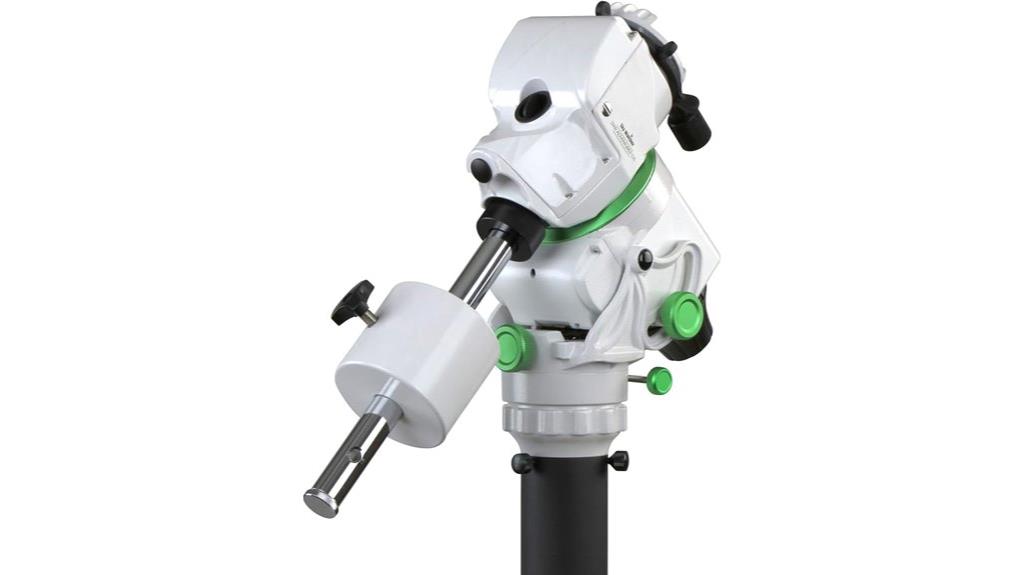
If you’re looking for a portable, feature-rich mount to elevate your astrophotography sessions, the Sky Watcher Star Adventurer GTI Mount Head Kit stands out as an excellent choice. It offers full GoTo equatorial tracking, Wi-Fi connectivity, and a built-in illuminated polar scope for precise alignment. Supporting payloads up to 11 pounds, it’s compatible with DSLR cameras, small astrographs, and compact telescopes. Its lightweight design, around 15 pounds, makes it easy to transport, and its multiple tracking modes—including lunar and solar—add versatility. While some users report minor build quality issues, overall, it provides reliable tracking and straightforward setup, making it ideal for mobile astrophotography adventures.
Best For: amateur astrophotographers seeking a portable, feature-rich mount for capturing deep-sky objects, planets, and lunar details with reliable tracking and easy setup.
Pros:
- Full GoTo equatorial tracking with Wi-Fi connectivity for remote control
- Supports payloads up to 11 pounds, suitable for DSLR, mirrorless, and small telescopes
- Lightweight, portable design (~15 pounds) ideal for mobile astrophotography
Cons:
- Occasional build quality issues, such as loose polar scope components or nonfunctional LED illuminators
- Battery compartment design can be problematic, requiring workaround solutions
- Limited support for some accessories without adapters and minor app connectivity hiccups
EQ6 Tripod to Wave Steel by Sky-Watcher
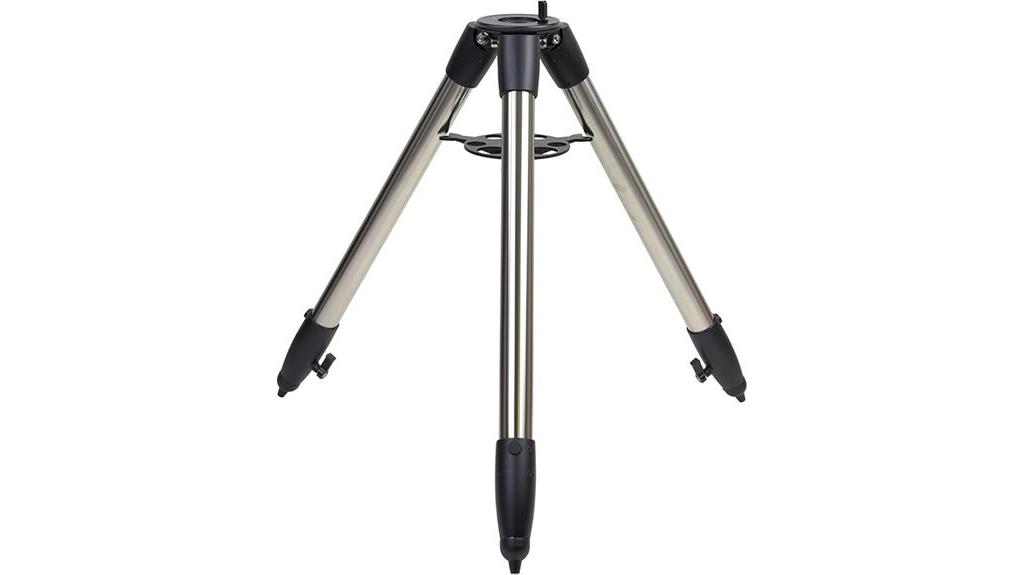
For astrophotographers seeking maximum stability, the EQ6 Tripod to Wave Steel by Sky-Watcher stands out with its robust 2-inch rolled steel legs. These provide exceptional support, reducing vibrations and ensuring sharp, clear images during long exposures. It’s compatible with Sky-Watcher’s Wave mounts, including NEQ6, EQ6, EQ6-R, and AZ-EQ6, but requires a Wave Pier Adapter for mounting. The sleek black finish adds a professional look that complements other Sky-Watcher equipment. Designed for stability and reliability, this tripod elevates your astrophotography setup, helping you capture the night sky with confidence and precision.
Best For: astrophotographers seeking maximum stability and vibration reduction for long-exposure imaging with Sky-Watcher Wave mounts.
Pros:
- Robust 2-inch rolled steel legs provide excellent stability and minimize vibrations.
- Compatible with multiple Sky-Watcher Wave mounts, including NEQ6, EQ6, EQ6-R, and AZ-EQ6.
- Sleek black finish offers a professional appearance that complements other equipment.
Cons:
- Requires a Wave Pier Adapter (S30916) for mounting, adding an extra component to setup.
- Heavier and possibly less portable due to its sturdy steel construction.
- Designed specifically for Sky-Watcher Wave mounts; not compatible with non-Sky-Watcher mounts.
Vortex Optics Mountain Pass Tripod Kit

When searching for a reliable tripod for astrophotography, the Vortex Optics Mountain Pass Tripod Kit stands out thanks to its lightweight design and sturdy construction. It’s compact and versatile, perfect for outdoor adventures from prairies to foothills. The two-way pan and tilt head, compatible with Arca-Swiss quick-release systems, ensures smooth tracking of celestial objects. Made of machined aluminum, it’s durable yet lightweight, supporting up to 22 pounds—enough for larger binoculars or spotting scopes. The adjustable telescoping legs lock easily with quick flip levers, making setup quick and adaptable. Plus, the unlimited warranty offers peace of mind for reliable, long-term use.
Best For: outdoor enthusiasts and astronomers seeking a lightweight, durable, and versatile tripod for astrophotography and nature observation.
Pros:
- Compact and lightweight design for easy portability during outdoor trips
- Machined aluminum construction offers durability while remaining lightweight
- 2-way pan and tilt head with Arca-Swiss compatibility enables smooth tracking and secure mounting
Cons:
- Maximum load capacity of 22 pounds may limit use with very large or heavy equipment
- Independent leg adjustments require manual operation, which may be less convenient in rapid setup scenarios
- Limited information on included accessories or additional features beyond the warranty
NEEWER Basic 74 Video Tripod Monopod

The NEEWER Basic 74 Video Tripod Monopod stands out as an excellent choice for astrophotographers seeking versatility and stability on a budget. Made from durable aluminum alloy, it’s lightweight at just 3.9 pounds and folds down to a compact size, making it easy to carry. Its adjustable legs extend from 23.6 to 74.4 inches, providing flexible height options for different shots. The 3-way pan tilt head ensures smooth movements, while nonslip rubber feet keep it stable on uneven terrain. Plus, it can detach into a monopod, and includes a Bluetooth remote and phone holder, making it perfect for solo astrophotography sessions.
Best For: amateur astrophotographers and outdoor enthusiasts looking for a versatile, budget-friendly tripod that offers stability, portability, and multi-functionality for capturing celestial and landscape shots.
Pros:
- Made from durable aluminum alloy, lightweight at only 3.9 pounds, and easily portable for outdoor use.
- Adjustable legs extend from 23.6 to 74.4 inches, providing flexible height options for various shots and terrains.
- Can detach into a monopod and includes a Bluetooth remote and phone holder, enhancing solo shooting versatility.
Cons:
- Some users report quality concerns such as loose swivels or plastic leg clasps affecting stability.
- The overall build, while functional, may lack the premium feel of more expensive tripods.
- Limited maximum load capacity (17.6 lb), which may restrict use with heavier or professional-grade equipment.
Factors to Consider When Choosing Tripods and Pier Mounts for Astrophotography
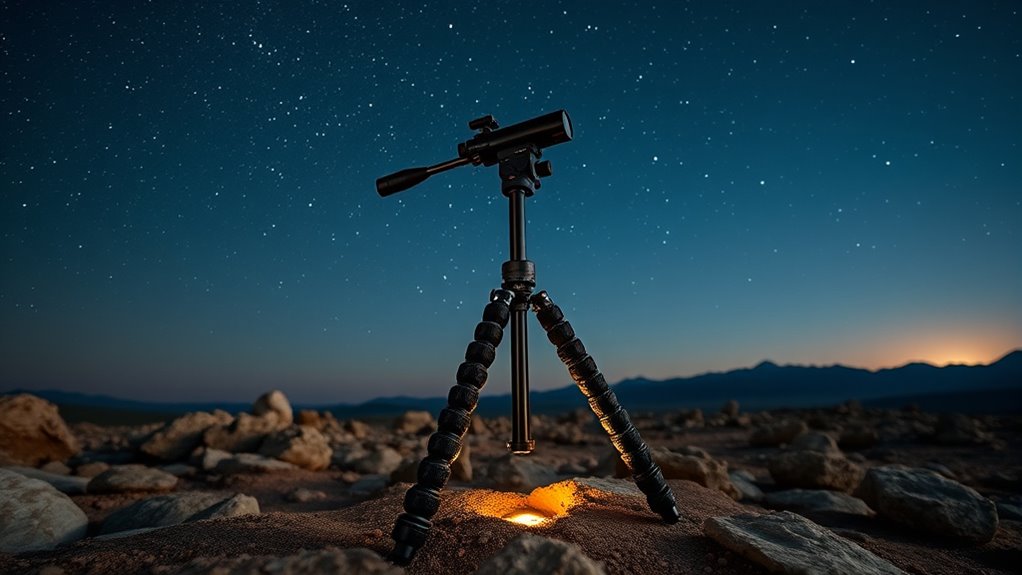
When selecting a tripod or pier mount for astrophotography, I focus on stability and vibration control to keep my images sharp. I also consider load capacity, portability, and how easily the setup can be adjusted and leveled to match my needs. Compatibility with my gear and the mounting options are equally important to guarantee a smooth shooting experience.
Stability and Vibration Control
Choosing a stable tripod or pier mount is vital for achieving sharp astrophotography images, especially during long exposures. A solid setup minimizes vibrations that can blur your shots. Materials like steel or aluminum with reinforced joints offer the rigidity needed to resist flexure under load, maintaining stability. Vibration damping features such as vibration suspension pads or shock-absorbing feet help absorb ground vibrations, further preventing image blur. Proper weight distribution and securing all screws ensure your equipment stays put, avoiding shifting or wobbling during captures. Elevated or sturdy pier mounts also help isolate your gear from ground vibrations, providing a more stable platform. Prioritizing stability and vibration control is essential for capturing clear, crisp images of the night sky.
Load Capacity Requirements
Selecting a tripod or pier mount that can handle your equipment’s weight is essential for stable astrophotography. I recommend choosing support that supports at least 50% more than your total payload to prevent instability and allow for future upgrades. Carefully consider the combined weight of your telescope, camera, and accessories, then select a mount with a rated load capacity exceeding this total. For heavier setups, opt for mounts rated at 20 pounds or more to ensure consistent stability during long exposures. Underestimating load capacity can cause vibrations, misalignments, or even damage your gear over time. Always check the manufacturer’s specified maximum load and avoid surpassing it to maintain tracking accuracy and protect your equipment during those critical night sky shots.
Portability and Ease
Portability and ease are essential factors when picking out tripods and pier mounts for astrophotography, especially if you plan to shoot from multiple locations. Lightweight options under 10 pounds make transportation manageable, allowing me to carry gear effortlessly across different sites. Compact designs that fold or collapse into smaller sizes speed up setup and teardown, giving me more time to capture the night sky. Features like quick-release plates and adjustable legs help me level the mount quickly, saving valuable imaging time. Wireless control compatibility, along with built-in Wi-Fi or Bluetooth, reduces cable clutter and makes remote operation straightforward in the field. Additionally, carrying cases or bags designed specifically for these mounts protect my equipment and streamline transportation, ensuring I can focus on capturing stunning astrophotos without hassle.
Compatibility and Mounting
Making sure your tripod or pier mount has the right mounting compatibility is vital, as mismatched threads or hole sizes can lead to instability or difficulty attaching your equipment. Check that the mounting hole sizes and thread standards, like 3/8-16 or 1/4-20, match your telescope or mount’s attachment points. Also, verify that the surface or plate can support your gear’s weight and size to prevent wobbling. Different mounts use V-style dovetails, Arca-Swiss, or proprietary plates—make sure they’re compatible with your accessories. Secure attachment is essential, so consider features like quick-release plates or clamps for easy setup. Additionally, an adjustable or leveling mounting system helps ensure proper alignment, minimizing frustration during your astrophotography sessions.
Adjustment and Leveling
When setting up your tripod or pier mount for astrophotography, precise adjustment and leveling can make all the difference in achieving sharp images. An adjustable tripod with independent leg locks and multi-angle legs is ideal for uneven terrain, helping you find a stable, level platform. Built-in bubble levels or adjustable feet are essential tools to guarantee your mount is perfectly horizontal before starting polar alignment or imaging. Incorporating a repositionable center column or a dedicated leveling base allows fine-tuning of height and tilt for maximum stability. Using a pier mount or extension with height adjustment and adjustable leveling screws further enhances alignment accuracy. A robust leveling system reduces vibrations, ensuring better tracking during long exposures and ultimately sharper night sky images.
Frequently Asked Questions
How Do Weather Conditions Impact Tripod Stability During Astrophotography Sessions?
Weather conditions definitely impact tripod stability during astrophotography. Wind can shake your setup, causing blurry images, while rain and moisture can weaken tripod legs or cause slipping. Cold temperatures make materials more brittle, risking damage. I always check the forecast, secure my tripod firmly, and use weight or stakes if needed. Staying aware of weather helps me keep my gear steady and captures sharp night sky shots.
What Are the Best Materials for Durable and Lightweight Astrophotography Tripods?
When choosing materials for astrophotography tripods, carbon fiber stands out like a lightweight feather with steel’s strength, offering durability and portability. I love how carbon fiber resists temperature changes and dampness, keeping my shots steady no matter the weather. Aluminum, meanwhile, provides a budget-friendly, sturdy option. Both materials guarantee I can chase stars confidently, knowing my tripod won’t let me down during those late-night sky captures.
How Does Tripod Height Influence Image Quality in Night Sky Photography?
Tripod height considerably impacts image quality in night sky photography because it determines your line of sight and stability. If it’s too low, you might strain or introduce vibrations; too high, and you risk wobbling or misalignment. I recommend adjusting the tripod height so your camera is at a comfortable eye level, ensuring stability and reducing vibrations, which results in sharper, clearer astrophotos.
Are There Specific Tripod Features That Help With Polar Alignment Accuracy?
Yes, I look for tripods with built-in bubble levels and quick-release plates, which help me achieve precise polar alignment easily. A sturdy, adjustable tripod head that allows smooth, fine movements is essential for accurate polar positioning. I also prefer tripods with low-vibration or dampening features, as they minimize movement during adjustments. These features make aligning my mount more accurate, resulting in sharper, more detailed night sky images.
What Maintenance Is Required to Ensure Long-Term Tripod Performance?
To keep my tripod performing flawlessly for years, I give it a quick wipe after each session to remove dust and moisture—imagine shielding it from the relentless elements! I also check the locks and joints regularly, tightening any loose parts. Every few months, I apply a light lubricant to the moving parts to ensure smooth operation. Proper maintenance maintains my gear steady and ready for those perfect night sky shots.
Conclusion
In the end, selecting the right tripod or pier mount is like finding the perfect dance partner for your night sky adventures. It’s about harmony, stability, and just the right touch of support to let your astrophotography truly shine. I hope this list guides you toward that ideal match, gently opening the door to breathtaking shots and unforgettable moments under the stars. Here’s to your next celestial journey—may your gear always keep pace with your dreams.

